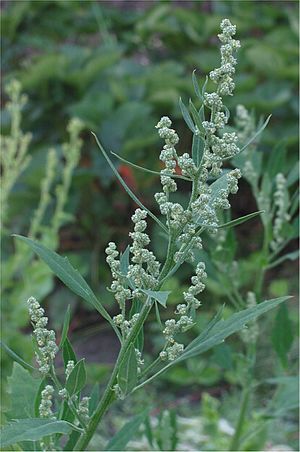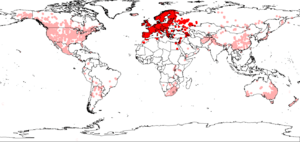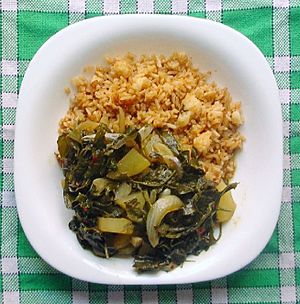Lamb's quarters facts for kids
Quick facts for kids Lamb's quarters |
|
|---|---|
 |
|
| Scientific classification | |
| Genus: |
Chenopodium
|
| Species: |
album
|
 |
|
| Occurrence download from GBIF | |
Chenopodium album is a common plant that grows quickly. You might know it by its other names like lamb's quarters, wild spinach, or fat-hen. While some people grow it on purpose, it's often seen as a weed in many places.
This plant is very popular in Northern India, where it's grown and eaten as a food crop called bathua.
Contents
Where Lamb's Quarters Grows
It's a bit of a mystery where this plant first grew naturally because it's been grown and moved around so much by people. We know it's from most of Europe, and it was first described there in 1753 by Carl Linnaeus.
Today, you can find Chenopodium album almost everywhere! It has spread to Africa, Australasia, North America, and Oceania. It especially likes to grow in soil that has a lot of nitrogen, like in empty lots or disturbed land.
What Lamb's Quarters Looks Like
This plant usually starts growing straight up. It can reach a height of about 10 to 150 centimeters (that's about 4 inches to 5 feet). Sometimes, it can even grow as tall as 3 meters (nearly 10 feet)! After it flowers, the plant often bends over because of the weight of its leaves and seeds.
The leaves of Chenopodium album are different depending on where they are on the plant. The lower leaves, near the bottom, are shaped a bit like a diamond and have jagged edges. The leaves higher up on the plant are narrower and smoother. They often have a waxy coating that makes them look a bit white or powdery, especially on the underside.
The plant has many small flowers. They are usually found in dense clusters at the end of the stems. These flowers are tiny and have five petal-like parts.
How Scientists Group Plants
Scientists group living things into categories, and Chenopodium album has a very complicated way of being grouped. There are many slightly different types of this plant, like subspecies and varieties, which can be hard to tell apart.
This plant can also mix its genes with other similar Chenopodium species. This creates hybrids, which are like mixed-breed plants.
Growing and Challenges
Chenopodium album is grown as a food crop or for animal feed in parts of Asia and Africa. However, in Europe and North America, it's often seen as a weed. For example, it can be a problem in potato fields. In Australia, it's even considered an environmental weed because it spreads easily and can harm native plants.
This plant is very strong and can compete with other crops for resources. It can cause problems for plants like corn, soybeans, and sugar beets. Farmers can try to control it by tilling the soil, using special tools, or burning young plants. Growing different crops in a field each year can also help. Some chemicals can also stop it from growing.
Did you know that the pollen from this plant can sometimes cause hay fever-like allergies in people?
Natural Pest Control
Interestingly, Chenopodium album can be helpful in some ways. It attracts tiny insects called leaf miners. This means it can be used as a trap crop. If you grow it near other plants you want to protect, the leaf miners might attack the lamb's quarters instead of your valuable crops. However, it can also be a host plant for the beet leafhopper, an insect that spreads a virus to beet crops.
Uses and How We Eat It
| Nutritional value per 100 g (3.5 oz) | |
|---|---|
| Energy | 180 kJ (43 kcal) |
|
7.3 g
|
|
| Dietary fiber | 4 g |
|
0.8 g
|
|
|
Protein
|
4.2 g
|
| Vitamins | Quantity
%DV†
|
| Vitamin A equiv. |
73%
580 μg |
| Thiamine (B1) |
14%
0.16 mg |
| Riboflavin (B2) |
37%
0.44 mg |
| Niacin (B3) |
8%
1.2 mg |
| Pantothenic acid (B5) |
2%
0.092 mg |
| Vitamin B6 |
21%
0.274 mg |
| Folate (B9) |
8%
30 μg |
| Vitamin C |
96%
80 mg |
| Minerals | Quantity
%DV†
|
| Calcium |
31%
309 mg |
| Iron |
9%
1.2 mg |
| Magnesium |
10%
34 mg |
| Manganese |
37%
0.782 mg |
| Phosphorus |
10%
72 mg |
| Potassium |
15%
452 mg |
| Sodium |
3%
43 mg |
| Zinc |
5%
0.44 mg |
|
Link to USDA Database entry
|
|
| †Percentages estimated using US recommendations for adults. | |
The leaves and young shoots of Chenopodium album can be eaten raw or cooked, much like spinach. However, it's best to eat them in small amounts because they contain something called oxalic acid. The flower buds and flowers can also be cooked and eaten.
Each plant makes thousands of tiny black seeds. These seeds are packed with protein, vitamin A, calcium, phosphorus, and potassium. A plant called Quinoa is a close relative of lamb's quarters and is grown specifically for its nutritious seeds. The Zuni people in North America cook the greens of young lamb's quarters plants.
Long ago, people even used these seeds as food. Archaeologists have found the seeds mixed with other grains at ancient sites from the Iron Age, Viking Age, and Roman times in Europe. They've even found them inside the stomachs of ancient bog bodies discovered in Denmark!
In India, where it's called bathua, it's very common in winter. The leaves and young shoots are used in many dishes like soups, curries, and stuffed breads called paratha. The seeds are used to make gruel-like dishes and even some mild alcoholic drinks. In the state of Haryana, a yogurt dip called "bathue ka raita" made with bathua is very popular in winter.
Food for Animals
As some of its common names suggest, Chenopodium album is also used to feed animals. Both the leaves and the seeds can be given to chickens and other poultry.
Building Material
Believe it or not, the juice from this plant was once used in building! An ancient Sanskrit book called the Samarāṅgaṇa Sūtradhāra, which is about Hindu art and construction, says that the plant's juice is a powerful ingredient for making wall plaster.
Traditional Uses
In Ayurveda, which is a traditional system of medicine from India, bathua is thought to help with different health problems. However, there isn't scientific proof that these uses are safe or work well.
Gallery
See also
 In Spanish: Chenopodium album para niños
In Spanish: Chenopodium album para niños





